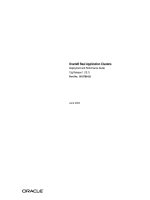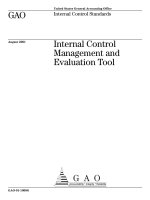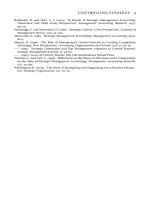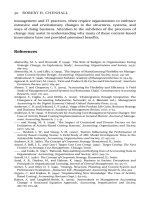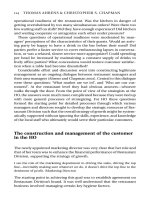Controlling strategy management and performance measurement_4 docx
Bạn đang xem bản rút gọn của tài liệu. Xem và tải ngay bản đầy đủ của tài liệu tại đây (640.42 KB, 21 trang )
organizational members to collect relevant information, and to engage
in face-to face dialogue and debate, which lead s to a focus on strategic
uncertainties. This process may lead to strategic change, through the
formation of emergent strategies. In contrast, when controls are used in
a diagnostic manner, they are used on an exception basis to monitor and
reward the achievemen t of goals. Controls will support key success
factors and the current strategy. Thus, in contrast to the content-focused
studies in the 1980s and 1990s, Simons’ framework does not examin e
which controls are used to support certain strategies; it considers the
style of use of formal controls by senior management.
Abernethy and Brownell (1999) studied how budgets can be used
interactively in a hospital setting, to moderate the relationship between
business strategy and organizational performance. They foun d that
organizational performance would be enhanced if budgeting was used
interactively in an organiz ation to reduce the disruptive effect associ-
ated with strategic change. The interactive mode was characterized as
an ongoing dialogue between organizational members as to why budget
variances occur, how systems and behaviours could be adapted to
minimize variances, and the actions that should be taken. This facili-
tates organizational learning. Survey data were collected from sixty-
three public hospitals. The aspect of strategic change that was studied
was the move to a more market-oriented stance, which was common
across the hospital sector.
Bisbe and Otley (2004) provide a comprehensive study of the effect of
the interactive use of control systems on product innovation. They
conducted a survey of 120 medium-sized mature Spanish manufactur-
ing firms, and tested whether the interactive use of controls leads
companies to develop and launch new products, and whether it con-
tributes to the impact of the new innovative products on organizational
performance. The control systems that were studied were the budgeting
system, the BSC system, and the project management system. Their
results indicated that in low innovating firms, the use of an interactive
control system may lead to greater innovation, by providing guidance
for the search, triggering, and stimulus of initiatives and through pro-
viding legitimacy for autonomous initiatives. However, in high innovat-
ing firms, interactive use of controls seemed to reduce innovation. This
was thought to be caused by the filtering out of initiatives that result
from the sharing and exposure of ideas. Another finding was that the
interactive use of controls moderated the impact of innovation on
organizational performance. This was though to be a result of the
direction, integration, and fine-tuning those interactive control systems
72 KIM LANGFIELD-SMITH
provide. Overall, support was found for the positive impact of formal
MCS on innovation and long-term performance.
Operational strategies and control systems
The focus of most studies up to the mid-1990s was on relating the design
of MCS to business strategies, which were identified in generic terms:
differentiation versus cost leadership, prospector versus defender. How-
ever, in recent years, a range of studies have emerged that focus on
specific aspects of differentiation, such as strategies based on quality,
timeliness, reliability, and customer service. These aspects of strategies
form the focus of operational strategies. Various management innov-
ations such as TQM, just in time (JIT), business process engineering,
and continuous improvement have developed to support such strat-
egies, and there are consequent implications for the development of
MCS. These MCS include ‘strategically focused’ MCS that have only
emerged in recent times, such as activity-based cost management
(ABCM) and target costing. They also include more traditional forms
of MCS, such as performance measurement systems and budgeting
systems, which may be tailored to provide specific support for the
operational strategy. The following section provides a review of studies
that have focused on the design of MCS to support quality strategies,
product-related strategies, and manufacturing flexibility strategies.
Quality strategies
The earliest studies that focused on quality strategies and MCS were
Daniel and Reitsperger (1991, 1992). In two more recent related studies,
Daniel and Reitsperger (1994) and Daniel et al. (1995) focused on the
relationships between MCS and quality strategies in US and Japanese
firms. They distinguished between two forms of quality strategies: zero-
defect strategy and economic confo rmance level (ECL) strategies.
2
2
The ECL model of quality control assumes that ‘quality is costly’ and proposes that a
cost-minimizing quality level can be achieved by balancing prevention and appraisal costs
against internal and external failure costs. The optimal ECL is the points at which costs are
minimized—where the marginal prevention and appraisal costs equal marginal failure
costs. Under this model the ECL would never occur at the zero-defect level. A zero-defect
strategy focuses on continuous improvement to achieve perfect quality performance.
WHAT DO WE KNOW ABOUT STRATEGY AND MCS? 73
While the literature suggests that Japanese managers follow a zero-
defect quality strategy and US managers an ECL strategy (e.g. Hayes
1981; Schonberger 1982), Daniel and Reitsperger (1994) found that most of
the Japanese and US mana gers in their sample adhered to a zero-defect
quality strategy, with significantly more followers in the USA than in
Japan. The aspect of MCS that was studied in both Daniel and Reitsper-
ger (1994) and Daniel et al. (1995) was the provision of goal setting and
feedback information about quality perform ance.
Daniel and Reitsperger (1994) found that while US manufacturing
managers adhered to zero-defect strategies more than Japanese man-
agers, fewer US managers received MCS information to support their
zero-defect strategies. Japanese managers were found to receive
MCS regardless of which of the two quality strategies they followed.
Interestingly Daniel et al. (1995) found that in US companies, as man-
agers moved up the corporate hierarchy they viewed quality as a high
strategic priority and were provided with more quality goals and m ore
feedback on quality performance. Quality strategies and feedback in US
companies were linked, but quality as a goal setting was not associated
with a quality strategy. In the Japanese companies no association
was found between quality strategies and the quality goals setting or
feedback.
In a survey of automotive and computer companies across four coun-
tries, Ittner and Larcker (1997) found that organizations following a
quality-oriented strategy made greater use of strategic control practices
that were consistent with the quality orientation. The strategic control
practices were oriented towards specifically supporting a quality strat-
egy, and focused on strategic implementation practices (action plans,
project controls, and management rewards), internal monitoring prac-
tices (feedback mechanisms, meetings, and board reviews) and external
monitoring practices (benchmarking, market research, and strategic
audits of products and processes). However, the extent of the relation-
ship between strategy and control practices varied by country. The
results indicated that in US and German organizations there was a
very strong relation, while in Japan extensive use was made of quality-
related control systems, regardless of the strategic orientation. Interest-
ingly, the alignment of quality strategies and strategic control practices
was not always associated with high organizational performance, and
this varied by industry. For some control practices there was a negative
performance effect, suggesting that formal control syst ems might re-
duce performance.
74 KIM LANGFIELD-SMITH
Product-related strategies
Product-related strategies may be considered an aspect of not only
business strategy but also operational strategy, as their success may be
affected directly at the manufa cturing, marketing, or product design
levels.
Davila (2000) studied MCS in new product development projects and
became aware of the role of MCS in reducing uncertainty. MCS were a
source of information used to close the gap between information re-
quired to perform a task and informa tion already on hand (Tushman
and Nadler 1978). He argued that as well as strategy and structure
influencing the design of MCS in the new product development area,
three forms of information gap (uncertainty) shape the design of MCS.
These are market-related uncertainty, technolo gy-related uncertainty,
and project scope. Using both case studies and a survey, Davila (2000)
included both financial and non-financial information in his definition
of MCS. He found that cost and design information had a positive effect
on performance, but time-related information hinders performance. He
also found that cost information was related to a low-cost strategy and
time-related information to a time-to-market strategy. However, there
was no significant relationship between customer information and cus-
tomer strategy. Davila (2000) found that MCS were not the only source
of information used to reduce uncertainty and that when technology is
the main source of uncertainty, prototyping may substitute for MCS.
However, when uncertainty comes from project scope or from the
market, MCS are more suited to reducing that uncertainty.
Abernethy et al. (2001) presented five case studies that focused on
product diversity and the design of the product costing system. While
costing systems are not always considered an aspect of MCS, in this case
the orientation was the use of costing systems to facilitate decision-
making and control. The study questioned the accepted premise that
sophisticated costing systems are associated with high levels of product
diversity and high levels of investment in advanced manufacturing
technology (AMT) and the associated increase in overhead cost. They
found that higher the product diversity, the more sophisticated is the
costing system, while low product diversity is associated with a simple
costing system. They found that if there was little or no investment in
AMT, an increase in product diversity would create a demand for a
sophisticated costing system. If there was a larger investment in AMT,
the costing system may not be as sophisticated.
WHAT DO WE KNOW ABOUT STRATEGY AND MCS? 75
Manufacturing flexibility and customer-focused strategies
Abernethy and Lillis (1995) interviewed managers of forty-two manufac-
turing businesses to study the impact of a manufacturing flexibility
strategy, as a form of customer-responsive strategy, on the design of
MCS. From their interviews they extracted a series of constructs. Flexi-
bility was defined as having three dimensions: technological difficulty in
making product changes, strategic commitment to flexibility, and turn-
around time to meet customer demands. MCS were defined in terms of
integrative liaison devices—teams, task forces, meetings, and spontan-
eous contacts—and efficiency-based performance measures. As pre-
dicted, they found a positive relation between a flexibility strategy and
the use of integrative liaison devices, supporting the role of such devices
to manage functional interdependencies needed in the pursuit of flexi-
bility. However, for both flexible and non-flexible firms there was a
positive relation between the use of integrative liaison devices and
firm performance. There was a negative relation between the use of
efficiency-based performance measures for the evaluation of manufac-
turing performance and the commitment to flexibility, and only in firms
that were ‘not flexible’ did the use of efficiency-based performance
measures correlate with higher firm performance.
Perera et al. (1997) extended Abernethy and Lillis (1995) by using a
survey method to examine customer-focused manufacturing strategies
that included cost, quality, flexibility, and dependability. They set out to
research an unanswered question from Abernethy and Lillis—whether
firms that follow a customer-focused strategy emphasize non-financial
manufacturing measures, and whether that is associated with enhanced
performance. Support was found for the association between a cus-
tomer-focused strategy and an emphasis on non-financial measures.
However, there was no link to performance. One explanation provided
for this result is that the role of the operational measurement system is
to direct attention and to motivate managers to focus attention towards
those aspects of operations that are of strategic importance, so relevant
outcomes may be increased job satisfaction and motivation rather than
firm-level performance outcomes. As with many studies of this nature
that seek to relate the use of various practices and systems with im-
proved firm performance, there are always questions about the nature of
the lag between behavioural outcomes and firm-level performance, or
more broadly how or if this linkage works in the light of so many other
factors that may mitigate such relationships.
76 KIM LANGFIELD-SMITH
MCS and strateg y in interfirm relationships
In recent years, the design and operation of MCS in interfirm relation-
ships has sparked the interest of several researchers. MCS is said to play
a role in the management of interdependencies between organizations,
in situations of outsourcing, joint ventures, and other strategic alliances.
Most studies have taken a process approach to examining the issues,
and various frameworks have been used to interpret the findings. For
example, Mouritsen et al. (2001) used actor-network theory, and van der
Meer-Kooistra and Vosselman (2000) and Langfield-Smith and Smith
(2003) use a modified transaction cost economics approach. However,
to date there are few studies that have focused on strategy and MCS in
interfirm relationships.
Mouritsen et al. (2001) provide two case studies of outsourcing that
highlight the interdependencies between strategy and control systems
of both partners. It is widely believed among many researchers and
practitioners that an important determinant of success in interorgani-
zational relationship is a supportive cooperative relationship based on
trust. Thus, careful consideration is needed in designing the control
system to manage the relationship. In both case studies, outsourcing
was regarded as part of the strategy of the firms, and was considered
critical for maintaining competitiveness. In both companies the advent
of outsourcing left a gap in the control system and new controls were
introduced to reinstall control and to retain a sense of involvement in
the outsourced activities.
The strategy of NewTech was focused on rapid technological devel-
opment. Technological innovation was considered key to maintaining
competitiveness, and in the light of this, some would say that such a
critical function should not have been outsourced. Functional analysis,
a part of target costing, was introduced to regain cont rol over the
product development function and became a way to improve the sup-
pliers’ understanding of the technology, strategy, and organization and
to direct the suppliers’development activities. NewTech became a tech-
nology coordinator and manager through these changes, and gained a
new identity.
Lean Tech found that, as customer demands changed, the strategy of
flexibility towards individual customers gave way to productivity. This
led not only to the outsourcing of production, but also to a lack of
control over those outsourced processes. Open book accounting was
introduced to provide logistics management with access to time and
WHAT DO WE KNOW ABOUT STRATEGY AND MCS? 77
cost information about production processes, which assisted the com-
pany to coordinate supplier activities and improved production flexibil-
ity. However, open book accounting also led to a new concepti on of
competitive strategy and a reinterpretation of what technological edge
and customization meant for the firm.
In both these case studies, the new controls that were introduced to
gain control over the outsourced activities led to changes in company
perception of what were the core competencies of the two firms and
new conceptualizations of the nature of their strategy and competitive
edge.
Strategic style of corporate HQ and the MCS
of business units
The spread of multinational organizations and the increasing complex-
ity of many business structures and arrangements have highlighted the
difficulty of managing at a distance, and the importance of achieving
control and strategic objectives. Some of the earliest research into man-
agement control addressed the issue of decentralization, and specified
appropriate control mechanisms. Bruns and Waterhouse (1975) found
that larger organizations tend to be more decentralized and place
greater reliance on formal administrative controls, such as budgets
(see Chenhall (2003) for a review of the literature). Distance seems to
make control more difficult, as there is less visibility of operations.
There are two interrelated perspectives that may be taken into ac-
count when researching this issue: the control systems that are used by
the parent to control business units, and the control systems that are
used within business units. Chenhall (2005) distinguishes between the
‘outside–in’ and ‘inside–out’ perspectives in considering the relation-
ships between strategy and MCS. However, the design of MCS within
business units can be influenced by a variety of factors, including the
will of the head office (HO) or parent company. Such MCS may be
imposed by mandate on divisions or subsidiaries to satisfy desires for
uniformity across a wider organization. Parental control can also extend
to actions and activities that exert control through various socialization
experiences and HRM interventions. From an HO perspective, one of
the challenges in controlling, particularly far-flung divisions, is commu-
nicating and coordinating decision-making, behaviours, activities, and
operations.
78 KIM LANGFIELD-SMITH
There are several ways of conceptualizing the form of control exer-
cised by a parent. Yan and Gray (2001) distinguish between strategic
control (exercised by the parent company or HO), operational control
(exercised by the business unit/divisional management), and structural
control (where procedures and routines are imposed on the business
unit by the parent). Nilsson (2000) and Chung et al. (2000) both used the
classification of financial control, strategic planning, and strategic con-
trol. Ahrens and Chapman (2004) adopted an enabling and coercive
classification to describe the control style of the HO.
Nilsson (2000) found a relationship between the parenting style and
the MCS in four company groups, as well as a relationship between the
business strategy pursued and the MCS. The Goold et al. (1994) classifi-
cation of parenting style of financial control, strategic planning, and
strategic control were used. A parenting style of financial control implies
a high degree of decentralization, where strategic planning is carried out
by the business units and those business units operate in stable mature
industries where there are opportunities to generate strong profit and
cash flows. In these situations a cost leadership strategy is appropriate
and the parent exercises controls through financial targets and report-
ing. A strategic planning style involves a high degree of synergy between
the business units and the parent, and parental involvement in planning
and decision-making. This is thought to suit situations where there is a
turbulent competitive environment and where a long-term perspective
is relevant. A differentiation strategy is often followed by the business
unit. Control is exercised by parents through their involvement in the
decision-making process and an emphasis on informal planni ng and
follow-up and non-financial information.
Chung et al. (2000) investigated how the strategic management (par-
ental) style employed by corporate HO to manage a diverse range of
subsidiaries affected the type of controls used. Again, the three forms of
strategic management style were strategic planning, strategic control,
and financial control (Goold and Campbell 1987). For those HOs using a
financial control style, emphasis was on output controls, namely setting
and monitoring financial targets. The development of business strategy
was delegated to the business units. The strategic planning style entails
the HO participating with and influencing the business strategy of the
business unit, and close interaction with the business unit is required.
A heavy focus was on behaviour controls. HOs that had a strategic
control style are strongly committed to decentralization, so they will
not directly impose business strategies or interfere in major decisions.
Rather, they will look for ways of socializing managers of subsidiaries
WHAT DO WE KNOW ABOUT STRATEGY AND MCS? 79
into the philosophy of the HO. While results did not support their hy-
potheses for the strat egic planning and strategic control style, they found
that a strategic control style was the most prevalent. They also found a
strong emphasis on socialization controls across all subsidiaries.
Ahrens and Chapman (2004 ) used a framework of coercive and enab-
ling (Adler and Borys 1996) uses of MCS to view the relationship between
HO and operational units within a restaurant chain. Coercive use is a
top–down approach that emphasizes centralization, pre-planning, and
detailed specification of organizational rules. An enabling use aims to
design a formal system that capitalizes on the intelligence of managers
by helping operational managers to deal more effectively with contin-
gencies, rather than tightly constraining them. The usability of formal
systems can be assessed in terms of repair, internal transparency, global
transparency, and flexibility. Repair provides the capability for users to
fix breakdowns in control processes. Internal transparency is an under-
standing of the workings of local control processes whereas global
transparency is an understanding of where and how these local pro-
cesses fit into the control systems of the organization as a whole. Flexi-
bility is the employees’ discretion over the use of control systems, even
to the point of turning these controls off. In their case study, Ahrens and
Chapman (2004) found that the HO used a mixture of coercive and
enabling controls. While this chapter does not deal explicitly with strat-
egy, it is argued that enabling control systems can provide operational
managers with the capability to deal with emerging contingencies in a
way that will further the local and organization-wide goals. In the case of
their restaurant chain case study, customer satisfaction was a driver of
sustained financial success. This was a broader concept than producing
high-quality meals and attentive service; it captured the restaurant
‘experience’. Thus, rigidly specified rules would not necessarily provide
the answer to achieving this strategic goal. Restaurant managers needed
to be able to respond to local circumstances, but without violating strict
efficiency parameters.
Summary and directions for future research
This chapter presented some research studies in the area of MCS and
strategy, following several themes. These are the relationship between
performance measures and reward systems (including BSC) and busi-
ness strategy; capital investment processes and the initiation of strategic
80 KIM LANGFIELD-SMITH
investment projects; interactive controls and strategic change; oper-
ational strategies and control systems; the design and operation of
MCS in interfirm relationships, such as joint ventures and outsourcing;
and the strategic style of corporate HQ and the MCS of business units.
Various different approaches have been taken in these studies, which
have added to our understanding of the complexity of the MCS–strategy
relationship. However, there is still so much that we need to understand,
which could form the focus for future research.
One promising direction for future research is in the area of perform-
ance measurement, reward systems, and BSC. Ittner et al. (2003b)
emphasized the need to go beyond the search for alignment of perform-
ance measures with strategy, to investigate more fully specific value
drivers of strategic success. ‘Traditional’ approaches to the study of
performance measures and strategy have focused on the use and bene-
fits of, or emphasis on, performance measures (Abernethy and Lillis 1995;
Chenhall and Langfield-Smith 1998; Baines and Langfield-Smith 2003)
and this is also true for empirical studies that have focused on BSC and
strategy (see Hoque and James 2000). However, other studies have
highlighted the critical nature of implementation issues, including
behavioural issues, in influencing whether or not these frameworks
achieve their intended outcomes. In pursuing this issue in more detail,
Ittner et al. (2003a) highlight the various interpretations that companies
may give to operationalizing the BSC concept, so that many firms do not
fully adopt the original Kaplan and Norton prescription. Many of the
future research directions in the area of performance measures and
strategy highlighted in Langfield-Smith (1997) remain unanswered, but
perhaps we have now moved on to focus on more important and
challenging areas.
Several studies have highlighted the many functions that control
systems may play within an organization, in influencing strategic
change, strategic thinking, and performance. Performance targets may
direct employee efforts towards improving key success criteria of the
firm (Chenhall and Langfield-Smith 2003). MCS may direct managerial
thinking towards initiating capital expenditure proposals that consider
the impact of the project on competitiveness (Miller and O’Leary 1997;
Slagmulder 1997). MCS can also influence managers’ conceptions of the
purpose and strategic direction of the firm (Mouritsen et al. 2001), and
lead to the building up of strategic knowledge among managers and
employees. Simons’ framework focuses attention on how managers can
select certain controls to use interactively to guide and direct attention
towards strategic uncertainties and strat egic change.
WHAT DO WE KNOW ABOUT STRATEGY AND MCS? 81
As organizations expand globally and operations move beyond their
traditional boundaries, there is a need to understand how MCS can be
designed and used to control these decentralized operations, and out-
sourced or joint venture activities, to promote strategic thinking, stra-
tegic behaviour, and sustained performance. It is only in the last few
years that these areas have emerged and they represent large unex-
plored opportunities for future studies.
Control systems seem to be designed to meet several purposes. How-
ever, can control systems that focus on influencing strategic thinking
also motivate employees to perform, as well as provide accountability
and control? Further research is needed to enhance our understanding
of the multiple objectives of control systems and whether a control
system that is designed to effect change or to influence thinking can
be used for other purposes.
This chapter has highlighted several areas for future research, which are
developed in other chapters of this book. These include developing an
understanding of how multiple objectives of control systems can be
achieved (Hansen and Mouritsen 2005); how strategic capital investment
practices and processes can be developed to encourage strategic thinking;
the design of controls systems in interorganizational relationships (Miller
and O’Leary 2005); and how MCS can be designed and used to promote
improved strategic performance and control through the creation of
strategic knowledge and strategic thinking (Ittner and Larcker 2005).
These topics will be explored in more detail in subsequent chapters.
References
Abernethy, M. A. and Brownell, P. (1999). ‘The Role of Budgets in Organizations Facing
Strategic Change: An Exploratory Study’, Accounting, Organizations and Society, 24:
189–204.
—— and Lillis, A. M. (1995). ‘The Impact of Manufacturing Flexibility on Management
Control System Design’, Accounting, Organizations and Society, 20(4): 241–58.
—— —— , Brownell, P., and Carter, P. (2001). ‘Product Diversity and Costing System Design
Choice: Field Study Evidence’, Management Accounting Research, 12: 261–79.
Adler, P. and Borys, B. (1996). ‘Two Types of Bureaucracy: Enabling and Coercive’, Admin-
istrative Science Quarterly, 41(1): 61–90.
Ahrens, T. and Chapman, C. S. (2002). ‘The Structuration of Legitimate Performance
Measures and Management: Day-to-Day Contests of Accountability in a U.K. Restaurant
Chain’, Management Accounting Research, 13(2): 151–71.
—— —— (2004). ‘Accounting for Flexibility and Efficiency: A Field Study of Management
Control Systems in a Restaurant Chain’, Contemporary Accounting Research, 21(2):
271–301.
82 KIM LANGFIELD-SMITH
Baines, A. and Langfield-Smith, K. (2003). ‘Antecedents to Management Accounting
Change: A Structural Equation Approach’, Accounting, Organizations and Society,
28(7/8): 675–98.
Banker, R. D., Chang, H., and Pizzini, M. J. (2004). ‘The Balanced Scorecard: Judgmental
Effects of Performance Measures Linked to Strategy’, The Accounting Review, 79(1): 1–23.
Bisbe, J. and Otley, D. (2004). ‘The Effects of the Interactive Use of Management Control
Systems on Product Innovation’, Accounting, Organizations and Society, 29: 709–37.
Briers, M. and Hirst, M. (1990). ‘The Role of Budgetary Information in Performance
Evaluation’, Accounting, Organizations and Society, 15: 373–98.
Bruns, W. J. Jr. and Waterhouse, J. H. (1975). ‘Budgetary Control and Organizational Struc-
ture’, Journal of Accounting Research (Autumn): 177–203.
Chenhall, R. H. (2003). ‘Management Control Systems Design Within Its Organizational
Context: Findings from Contingency-Based Research and Directions for the Future’,
Accounting Organizations and Society, 28(2/3): 127–68.
—— (2005). ‘Content and Process Approaches to Studying Strategy and Management
Control Systems’, in C. S. Chapman (ed.), Controlling Strategy: Management, Accounting
and Performance Measurement. Oxford: Oxford University Press.
—— and Langfield-Smith, K. (1998). ‘The Relationship between Strategic Priorities, Man-
agement Techniques and Management Accounting: An Empirical Investigation Using a
Systems Approach’, Accounting, Organizations and Society, 23(3): 243–64.
—— —— (2003). ‘Performance Measurement and Reward Systems, Trust and Strategic
Change’, Journal of Management Accounting Research, 15: 117–44.
Chung, L. H., Gibbons, P. T., and Schoch, H. P. (2000). ‘The Influence of Subsidiary Context
and Head Office Strategic Management Style on Control in MNCs: The Experience in
Australia’, Accounting, Auditing and Accountability Journal, 13(5): 647–66.
Daniel, S. J. and Reitsperger, W. D. (1991). ‘Linking Quality Strategy with Management
Control Systems: Empirical Evidence from Japanese Industry’, Accounting, Organiza-
tions and Society, 16: 601–18.
—— —— (1992). ‘Management Control Systems for Quality: An Empirical Comparison of
the US and Japanese Electronic Industries’, Journal of Management Accounting Research,
4: 64–78.
—— —— (1994). ‘Strategic Control Systems for Quality: An Empirical Comparison of the
Japanese and U.S. Electronics Industries’, Journal of International Business Studies, 25:
275–94.
—— —— , and Gregson, T. (1995). ‘Quality Consciousness in Japanese and U.S. Electronics
Manufacturers: An Examination of the Impact of Quality Strategy and Management
Control Systems on Perceptions of the Importance of Quality to Expected Management
Rewards’, Management Accounting Research, 6: 367–82.
Davila, T. (2000). ‘An Empirical Study on the Drivers of Management Control Systems’
Design in New Product Development’, Accounting, Organizations and Society, 25:
383–409.
Govindarajan, V. (1988). ‘A Contingency Approach to Strategy Implementation at the
Business-Unit Level: Integrating Administrative Mechanisms with Strategy’, Academy
of Management Journal, 31(4): 828–53.
Govindarajan, V. and Gupta, A. K. (1985). ‘Linking Control Systems to Business Unit
Strategy: Impact on Performance’, Accounting, Organizations and Society, 20: 51–66.
Goold, M. and Campbell, A. (1987). ‘Managing Diversity: Strategy and Control in Diversified
British Companies’, Long Range Planning, 20(5): 42–52.
—— —— , and Alexander, M. (1994). Corporate Level Strategy: Creating Value in the Multi-
business Company. New York: John Wiley.
Gupta, A. K. (1987). ‘SBU Strategies, Corporate-SBU, and SBU Effectiveness in Strategy
Implementation’, Academy of Management Journal, 30(3): 477–500.
WHAT DO WE KNOW ABOUT STRATEGY AND MCS? 83
Haka, S. F. (1987). ‘Capital Budgeting Techniques and Firm Specific Contingencies:
A Correlational Analysis’, Accounting, Organizations and Society, 12(1): 31–48.
Hansen, A. and Mouritsen, J. (2005). ‘Strategies and Organisational Problems: Constructing
Corporate Value and Coherence in Balanced Scorecard Processes’, in C. S. Chapman
(ed.), Controlling Strategy: Management, Accounting and Performance Measurement.
Oxford: Oxford University Press.
Hayes, R. H. (1981). ‘Why Japanese Factories Work’, Harvard Business Review (July/Aug.)
56–66.
Hoque, Z. and James, W. (2000). ‘Linking Balanced Scorecard Measures to Size and Market
Factors: Impact on Organizational Performance’, Journal of Management Accounting
Research, 12: 1–17.
Ittner, C. and Larcker, D. (1997). ‘Quality Strategy, Strategic Control Systems, and Organ-
izational Performance’, Accounting, Organizations and Society, 22(3/4): 293–314.
—— —— (1998). ‘Innovations in Performance Measurement: Trends and Research Impli-
cations’, Journal of Management Accounting Research, 10: 205–38.
—— —— (2005). ‘Moving from Strategic Measurement to Strategic Data Analysis’, in C. S.
Chapman (ed.), Controlling Strategy: Management, Accounting and Performance Meas-
urement. Oxford: Oxford University Press.
—— —— , and Meyer, M. W. (2003a). ‘Subjectivity and the Weighting of Performance
Measures: Evidence from a Balanced Scorecard’, The Accounting Review, 78(3): 725–58.
—— —— , and Randall, T. (2003b). ‘Performance Implications of Strategic Performance
Measurement in Financial Services Firms’, Accounting, Organizations and Society, 28:
715–41.
Kaplan, R. S. ( 1986). ‘The Role for Empirical Research in Management Accounting’,
Accounting, Organizations and Society, 11: 429–52.
—— and Norton, D. P. (1992). ‘The Balanced Scorecard—Measures that Drive Performance’,
Harvard Business Review (Jan./Feb.): 71–79.
—— —— (1996). ‘Using the Balanced Scorecard as a Strategic Management System’, Har-
vard Business Review (Jan./Feb.): 75–85.
Langfield-Smith, K. (1997). ‘Management Control Systems and Strategy: A Critical Review’,
Accounting, Organizations and Society, 22: 207–32.
—— and Smith D. (2003). ‘Management Control and Trust in Outsourcing Relationships’,
Management Accounting Research, 14(3): 281–307.
Larcker, D. F. (1981). ‘The Perceived Importance of Selected Information Characteristics for
Strategic Capital Budgeting Decisions’, Accounting Review, 56: 519–38.
Malina, M. A. and Selto, F. H. (2001). ‘Communicating and Controlling Strategy: An Empir-
ical Study of the Effectiveness of the Balanced Scorecard’, Journal of Management
Accounting Research, 13: 47–90.
Merchant, K. A. (1989). Rewarding Results: Motivating Profit Center Managers. Boston, MA:
Harvard Business School Press.
Miller, P. and O’Leary, T. (1997). ‘Capital Budgeting Practices and Complementarity Rela-
tions in the Transition to Modern Manufacturing: A Field-Based Analysis’, Journal of
Accounting Research, 35(2): 257–71.
—— —— (2005). ‘Capital Budgeting, Coordination and Strategy: A Field Study of Inter-
firm and Intra-firm Mechanisms’, in C. S. Chapman (ed.), Controlling Strategy: Manage-
ment, Accounting and Performance Measurement. Oxford: Oxford University Press.
Mouritsen, J., Hansen, A., and Hansen C. O. (2001). ‘Inter-organization Controls and
Organizational Competencies: Episodes around Target Cost Management/Functional
Analysis and Open Book Accounting’, Management Accounting Research, 12: 221–44.
Nilsson, F. (2000). ‘Parenting Styles and Value Creation: A Management Control Approach’,
Management Accounting Research, 11: 89–112.
84 KIM LANGFIELD-SMITH
Perera, S., Harrison, G., and Poole, M. (1997). ‘Customer-Focused Manufacturing Strategy
and the Use of Operations-Based Non-Financial Performance Measures: A Research
Note’, Accounting, Organizations and Society, 22: 557–72.
Porter, M. E. (1980). Competitive Strategy. New York: Free Press.
Samson, D. A., Langfield-Smith, K., and McBride, P. (1991). ‘The Alignment of Management
Accounting with Manufacturing Priorities—a Strategic Perspective’, Australian Account-
ing Review, 1(1): 29–40.
Schonberger, R. J. (1982). Japanese Manufacturing Techniques: Nine Hidden Lessons in
Simplicity. New York: Free Press.
Shank, J. K. and Govindarajan, V. (1992). ‘Strategic Cost Analysis of Technological Invest-
ments’, Sloan Management Review (Fall): 39–51.
Simons, R. (1987). ‘Accounting Control Systems and Business Strategy: An Empirical An-
alysis’, Accounting, Organizations and Society, 12: 357–74.
—— (1990). ‘The Role of Management Control Systems in Creating Competitive Advan-
tage: New Perspectives’, Accounting, Organizations and Society, 15: 127–43.
—— (1995). Levers of Control. Cambridge, MA: Harvard Business School Press.
—— (2000). Performance measurement and control systems for implementing strateg y.
Upper Saddle River, NJ: Prentice-Hall.
Slagmulder, R. (1997). ‘Using Management Control Systems to Achieve Alignment between
Strategic Investment Decisions and Strategy’, Management Accounting Research, 8:
103–39.
Tushman, M. and Nadler, D. (1978). ‘Information Processing as an Integrating Concept in
Organizational Design’, Academy of Management Review, 3: 613–24.
van der Meer-Kooistra, J. and Vosselman, E. (2000). ‘Management Control of Inter-firm
Transactional Relationships: The Case of Industrial Renovation and Maintenance’,
Accounting, Organizations and Society, 25(1): 51–77.
Yan, A. and Gray, B. (2001). ‘Antecedents and Effects of Parent Control in International Joint
Ventures’, Journal of Management Studies, 38(3): 393–416.
WHAT DO WE KNOW ABOUT STRATEGY AND MCS? 85
Moving from Strategic Measurement
to Strategic Data Analysis
Christopher D. Ittner and David F. Larcker
Management control theories argue that the key goals of strategic con-
trol systems are communicating strategic direction and priorities, devel-
oping mechanisms for determining whether the chosen strategy is
achieving its objectives, and providing information that can be used to
modify actions in order to achieve desired goals. As discussed in other
chapters, the initial development of strategic control systems requires
the firm to determine the system’s primary objectives (Hansen and
Mouritsen 2005), allocate resources to achieve these objectives (Miller
and O’Leary 2005), and develop formal and informal control systems for
guiding and evaluating routines and practices for consistency with
strategic goals (Ahrens and Chapman 2005). While choices regarding
system objectives, resource allocation methods, and specific perform-
ance m easures are all critical issues in strategic control system imple-
mentation and success, an equally important issue is establishing the
organizational mechanisms needed to promote ongoing analysis of
strategic success and encourage strategic learning. Although manage-
ment control literature argues that such ‘feedback loops’, ‘double-loop
learning’, and ‘strategic data analyses’ are critical components of stra-
tegic control systems (e.g. Schreyogg and Steinmann 1987; Kaplan and
Norton 1996; Julian and Scifres 2002), relatively little is known about how
these strategic analysis mechanisms influence strategic control system
design and effectiveness. Moreover, despite growing evidence that
greater use of these mechanisms is associated with higher perceived
measurement system success and improved financial performance
(Sandt et al. 2001; Ittner and Larcker 2003; Marr 2004), surveys indicate
that most companies with strategic performance measurement systems
do not perform these analyses (Gates 1999; Ittner and Larcker 2003;
Ittner et al. 2003), raising important questions about the factors that
promote or hinder their use and effectiveness.
Over the past decade, we have investigated these issues in a variety of
contexts, ranging from the measurement of quality improvement initia-
tives and customer satisfaction programmes to the development of
balanced scorecards (BSC) and executive dashboards. In this chapter,
we synthesize our findings on the potential benefits from accompanying
strategic performance measurement systems with ongoing strategic
data analysis, and discuss some of the technical and organizational
factors hindering the develo pment of effective strategic data analysis
mechanisms.
The roles of data analysis in strategic control systems
Simon’s classic study of the controllersh ip function (Simon et al. 1954)
identified three roles for accounting information: attention directing,
scorekeeping, and problem solving. Similarly, the strategic measure-
ment and control literature describes three analogous roles for these
systems: (a) communicating strategic direction and priorities, (b) deter-
mining whether the strategy is being implemented as planned and the
results produced by the strategy are those intended, and (c) providing
information that can be used to promote organizational learning, to
identify avenues for improving strategic performance, and to adapt the
strategy to emerging conditions.
According to this literature, data acquisition and analysis are critical
elements in strategic measurement and control system effectiveness. A
representative strategic data analysis process, developed by one of our
research sites, is illustrated in Figure 1. Lorange et al. (1986 ) contend that
‘strategic controllers’ should undertake such a process in order to better
understand the underlying drivers of strategic results. Julian and Scifres
(2002) argue that data analysis and interpretation are essential in facili-
tating the identification of factors that trigger the need for strategic
change. Schreyogg and Steinmann (1987) point out that the very prem-
ises underlying the strategy being communicated to the organization
are based on assumptions that must be verified through data analysis. In
a similar vein, Kaplan and Norton (1996) emphasize that the ‘strat egy
maps’ communicating how improvements in chosen BSC performance
measures are expected to produce strategic results are merely hypoth-
eses that need to be tested.
Assessment of implementation and strategic success, in turn, requires
the development of valid and reliable measures for the hypothesized key
success factors (e.g. what specific measures and measurement method-
ologies actually tell us whether we are achieving our implementation
goals or strategic objectives?), the weighting of different types of meas-
ures (e.g. how do we ‘balance’ short-term goals against longer-term
FROM STRATEGIC MEASUREMENT TO ANALYSIS 87
strategic objectives?), and the identification of performance standards
for the hypothesized success factors (e.g. do we want to maximize per-
formance on every dimension, i.e. every customer or employee is 100 per
cent satisfied or loyal, or is some other performance standard more
appropriate?). These assessments require analysis of available data, or
the gathering and interpretation of new data when the existing system
does not provide the information needed to examin e these issues
(Muralidharan 1997; Ittner and Larcker 2003).
Finally, the use of strategic measurement systems for decision-mak-
ing and learning purposes requires organizations to undertake increas-
ingly detailed data analyses to uncover the underlying drivers or root
causes of strategic success, the potential benefits from specific strategic
investments, and the reasons behind deviations from strategic targets
(e.g. Argyris 1982; Hayes et al. 1988; Kaplan and Norton 1996; Julian and
Scifres 2002).
To examine these potential uses and benefits in greater detail, we
conducted extensive field research in more than sixty companies, and
supplemented this field research with survey-based studies in a broad
spectrum of public-and private-sector organizations. Our research
identified three primary benefits from strategic data analysis, including
Decisions/Actions
• Competitive Strategy
• Process Improvements
• New Products/Services
Data
• External surveys
• Internal tracking
• Benchmarking
Results
• Shareholder outcomes
• Customer outcomes
• Employee outcomes
Information
• Productivity
• Competence
• Resource allocation
Data collection
Analysis and Interpretation
Communicating
Linkage analysis
Figure 1 Strategic data analysis process
88 CHRISTOPHERD.ITTNER&DAVIDF.LARCKER
enhanced communication of strategic assump tions, better identifica-
tion and measurement of strategic value drivers, and improved resource
allocation and target setting. The following examples illustrate the role
of strategic data analysis in achieving these benefits.
Strategic marketing metrics in a convenience store chain
Although most companies make some effort to tie their performance
measures to the org anization’s strategy, these links are often based on
management intuition or organizational folklore about these relations
rather than rigorous analysis. A study of strategic performance meas-
urement systems by the Conference Board (Gates 1999), for example,
found that 69 per cent of companies attempt to determine the associ-
ations between their performance measures and the organization’s
strategy when choosing performance measures, but only 22 per cent
assess these links in a rigorous manner.
One important reason for the intuitive approach to choosing perform-
ance measures is the absence of any formal attempt to understand how
the company’s various financial and non-financial measures are
expected to fit together or produce desired strategic results. Many pro-
ponents of strategic performance measures argue that companies
should develop causal ‘business models’ or ‘value driver maps’ that
articulate the cause-and-effect relations among performance measures,
and show how improvements in these measures are expected to im-
prove long-term strategic and economic performance. However, less
than 30 per cent of the companies we surveyed have developed these
strategic ‘business models’ or ‘value driver maps’, and even fewer actu-
ally test whether the specific performance measures they have chosen
are associated with expected results. In fact, only 21 per cent of the
companies we surveyed even attempt to demonstrate that improve-
ments in their strategic performance measures actually influence future
financial results.
Typical is a large retailer in the US. The company owns and operates
hundreds of convenience stores that sell gasoline along with various food
and convenience items. A number of unarticulated assumptions under-
pinned its strategic plan and performance measures, with little or no
attempt to determine the validity of these assumptions. One of the most
firmly held assumptions was that gasoline sales and food sales were
unrelated. Rather than seeing these as complementar y product lines
FROM STRATEGIC MEASUREMENT TO ANALYSIS 89
that offered cross-selling opportunities, the company saw their joint sale
as an op portunity to increase the utilization of fixed resources. When we
questioned a wide variety of managers at different organizational levels
about this assumption, each asserted that no one had ever found a
relationship between gasoline sales and food sales. However, when
pushed, no one could tell us where this analysis was or who had done it.
Based on the assumption that gasoline and food sales were uncon-
nected, each product line was set-up as a separate profit centre. Market-
ing decisions across the two profit centres were not coordinated, and the
performance measures reported to one profit centre manager were not
reported to the other. When we subsequently analysed the company’s
data, we found no support for this key strategic assumption. As shown in
Figure 2, gasoline sales were highly correlated with food sales. Given the
higher profit margins on food sales, these results suggested the potential
to reduce gasoline prices (and increase gallons sold) in order to increase
profits through food sales. For example, by reducing gasoline prices
below those of nearby competitors, the stores could attract more gas-
oline buyers, who were then likely to buy high-margin food products
during the visit. The net effect would be an overall increase in store
profitability. In contrast, under the existing s trategic assumption that
gasoline and food sales were independent, prices on low-margin gas-
oline would never be reduced below that of competitors unless the
resulting increase in volume had a direct effect on gasoline profits, with
no consideration given to spillover effects on other products.
0.00
0.05
0.10
0.15
0.20
Jan. Feb. Mar. Apr. May June July Aug. Sept. Oct. Nov. Dec.
Slope 2000 Slope 2001
Figure 2 Estimated elasticities from cross-sectional regressions of convenience
store food sales ($US) on gasoline sales (gallons)
90 CHRISTOPHER D. ITTNER & DAVID F. LARCKER
Additional analysis also found that the elasticity between food and
gasoline sales varied with factors such as store size, location, and time of
year, providing information that allowed the company to tailor its stra-
tegic pricing policy. For example, in settings where gasoline and food
sales were highly interdependent, it made economic sense to reduce
gasoline prices (and therefore gasoline profitability) in order to increase
higher-margin food sales and overall store profits. The expected return
from each one penny drop in prices could be calculated based on the
estimated increase in food sales and profits for each store, providing
information on the optimal trade-off between gasoline profitability re-
ductions and increased food profitability. Conversely, in settings where
gasoline and food sales were unrelated, the existing practice of pricing
the two product lines independently could be retained.
The results from these analyses prompted the company to explicitly
articulate and analyse some of its other implicit strategic assumptions.
These included the belief that the only factors explaining food profit-
ability were store location and the sales of beer and cigarettes. To assess
the attractiveness of a given store location, the company used a scoring
model developed by a consulting firm that weighted factors such as
income level, traffic patterns, and competition into an overall index of
location desirability. Employee measures were not considered import-
ant to store profits, and were not reported to the gasoline and food profit
centre managers.
Analysis of this broader strategic model of food profitability provided
only partial support for the company’s beliefs. Consistent with their
expectations, the resulting statistical model (shown in Figure 3) indi-
cated that food profitability was positively related to beer and cigarette
sales. That is, stores that sold more beer and cigarettes as a percentage
of total food sales had higher food profitability due to the hig her mar-
gins on these two product lines. However, gasoline sales continued to
predict food sales profitability, as did employee measures such as turn-
over and workforce injuries, which were believed to have no effect on
store performance. Higher employee turnover had an indirect effect on
food profitability through its negative impact on customer satisfaction
(as measured using ‘mystery shopper’ results). The number of work-
place injuries, on the other hand, exhibited a direct negative effect on
food profits, reflecting the impact of poor working conditions on em-
ployee safety and morale. In contrast, the store location index had no
ability to differentiate food (or store) profitability, even though the
company used this index for assessing new store locations and closing
existing stores. While some of the individual location factors, such as the
FROM STRATEGIC MEASUREMENT TO ANALYSIS 91
Employee turnover
Customer satisfaction
Food profit/Sq Foot
Notation: +/− refers to a strong statistical positive/negative link;
insignificant links are not reported
(precise numbers are not reported at company request)
Gasoline gallons sold
Number of workplace injuries
Beer sales/food sales
Cigarette sales/food sales
−
+
+
+
+
−
+
Figure 3 Analysis of the drivers of food sales profitability in convenience stores

